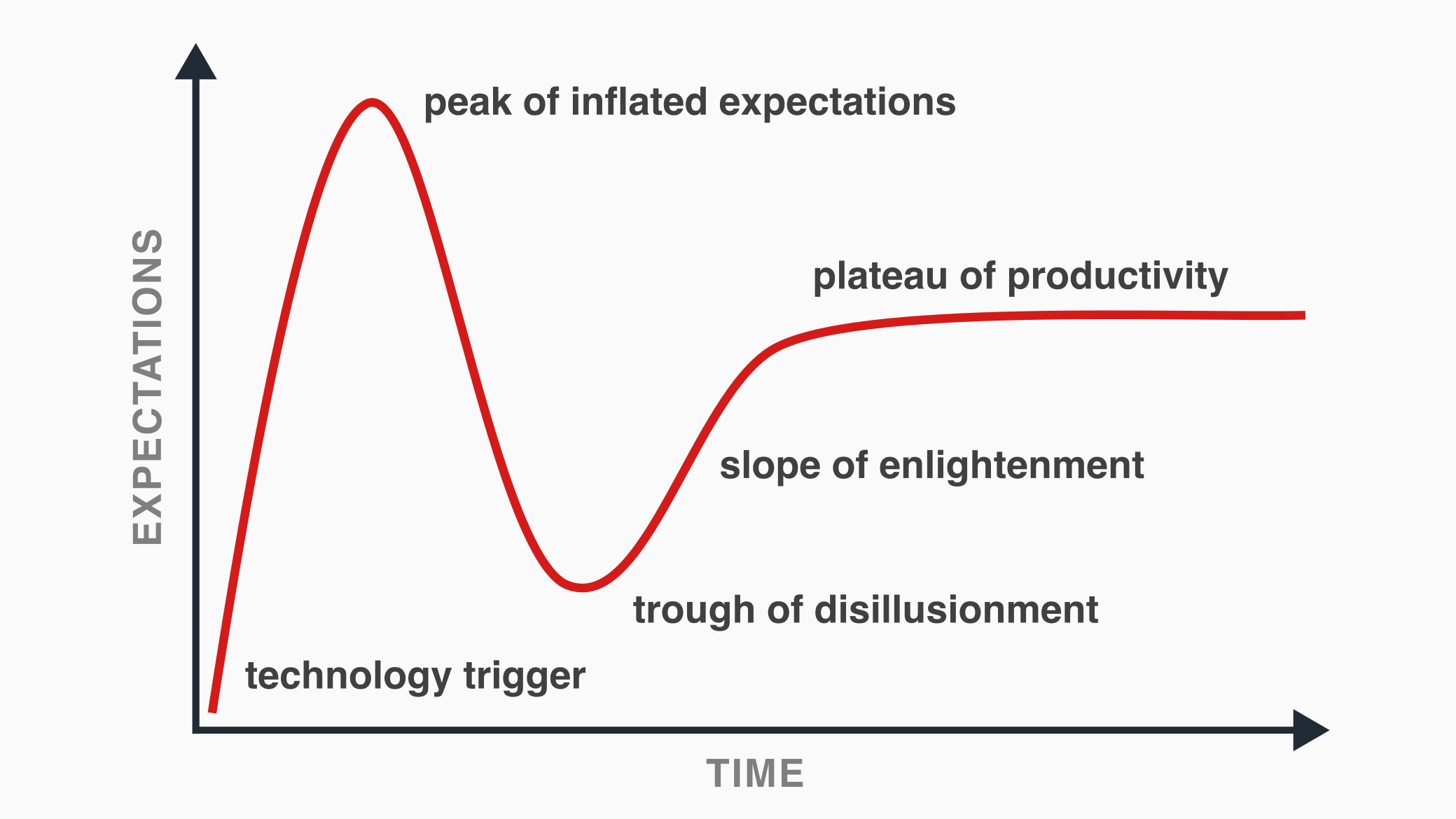The five stages of job satisfaction

Most people who have a background in technology consulting or business informatics will undoubtedly have heard of the Gartner hype cycle, which describes the five phases that new technologies go through:
-
Technology trigger: A new technology is presented to the world. Early proof-of-concept stories trigger a significant amount of publicity.
-
Peak of inflated expectations: Actual success stories are published for the fledgling technology. There are failures too, but people don’t care too much about those right now. Surely the kinks will be ironed out soon?
-
Trough of disillusionment: The new technology fails to deliver on its promises. Most projects and initiatives based on the new technology are terminated. The few that remain struggle to survive.
-
Slope of enlightenment: Now that the technology is more widely understood and products based on the technology are actually capable of meeting business needs, many companies start adopting the technology again.
-
Plateau of productivity: The technology has matured enough to achieve mainstream adoption.

The Gartner hype cycle is primarily used to market and sell , but aside from that it’s kind of useless: it’s not particularly helpful to decision makers and about as scientific as astrology. Heck, it doesn’t even describe a cycle.
I would even go as far as to say that the Gartner hype cycle is so vague and meaningless that – just like a horoscope – with a little bit of effort you can apply it to pretty much everything. I once wrote . Today I’m going to do that again, but this time I’ll use the Gartner hype cycle to describe the five phases of job satisfaction.
The aptly named Chun’s job satisfaction cycle is very similar to its spiritual predecessor in that it also doesn’t have any scientific basis. I named it after myself not only because I came up with it, but also as a way to cover my ass if it turns out its ideas don’t apply to everyone else – it’s my cycle after all.
Chun’s job satisfaction cycle is essentially a mirrored version of the original and also consists of five distinct phases:

-
Onboarding slide: You spent weeks in anticipation of the big day and now it’s finally there. You’re given your new work laptop (a shiny new MacBook Pro!), a grand tour through the office building (or if you’re lucky: the entire campus!) and get to meet your new colleagues, who are all incredibly friendly and eager to help. You are excited, your colleagues are excited, and whoever recruited you is excited… -ly enjoying their bonus somewhere on a beach in a tropical country. Things are off to a great start!
Of course, at some point people start to expect contributions from you, in the form of ideas, reviews, and working code. And that’s where the problems start…
-
Impostor syndrome valley: You left your old job, because there was nothing left to learn and you like learning new things all the time. Or so you thought.
Your new codebase is written in a language that you know (I mean, you passed the interview), but somehow you can’t make heads or tails of it. Everything feels so complicated and… different. Even the documentation – that’s assuming it even exists – doesn’t help a lot. You ask your new colleagues for help. They draw lots and lots of boxes and arrows on a whiteboard, walk you through the code, show you what the code is for, but none of it seems to help: it’s all Greek to you and you start to wonder whether you’re actually qualified for this new job.
-
Hill of happiness: False alarm! After a few more days or poking around you learned that the new codebase isn’t so scary after all. Better still, your first pull request has just made it to production and everyone – fellow developers, managers, end users – is praising the quality of your work. You’re proud of your work and the company. You definitely made the right choice in applying for this job.
-
Plain of productivity: I guess time really does fly when you’re having fun, because several years have passed now. Things are good here. Everything goes smoothly, there are few or even no major challenges, and you get along well with all your colleagues. You’re absolutely nailing it as a team and you’re being handsomely rewarded for all that hard work… with a steady paycheck and a yearly pay increase that’s just enough to cover absolutely nothing.
-
Cliff of internal resignation: Something happens; maybe it’s new leadership, a cultural change, a strained work relationship, or a less-than-stellar performance review. Or maybe you just start to grow tired of things.
Either way, it makes you lose most of your motivation to go to work. You’ll still go to work and file all your TPS reports of course, but you no longer care. It’s almost as if in your mind you have already resigned from your job. Once you reach this point, there’s really only one thing you should do: .
So, where are you in this job satisfaction cycle?


